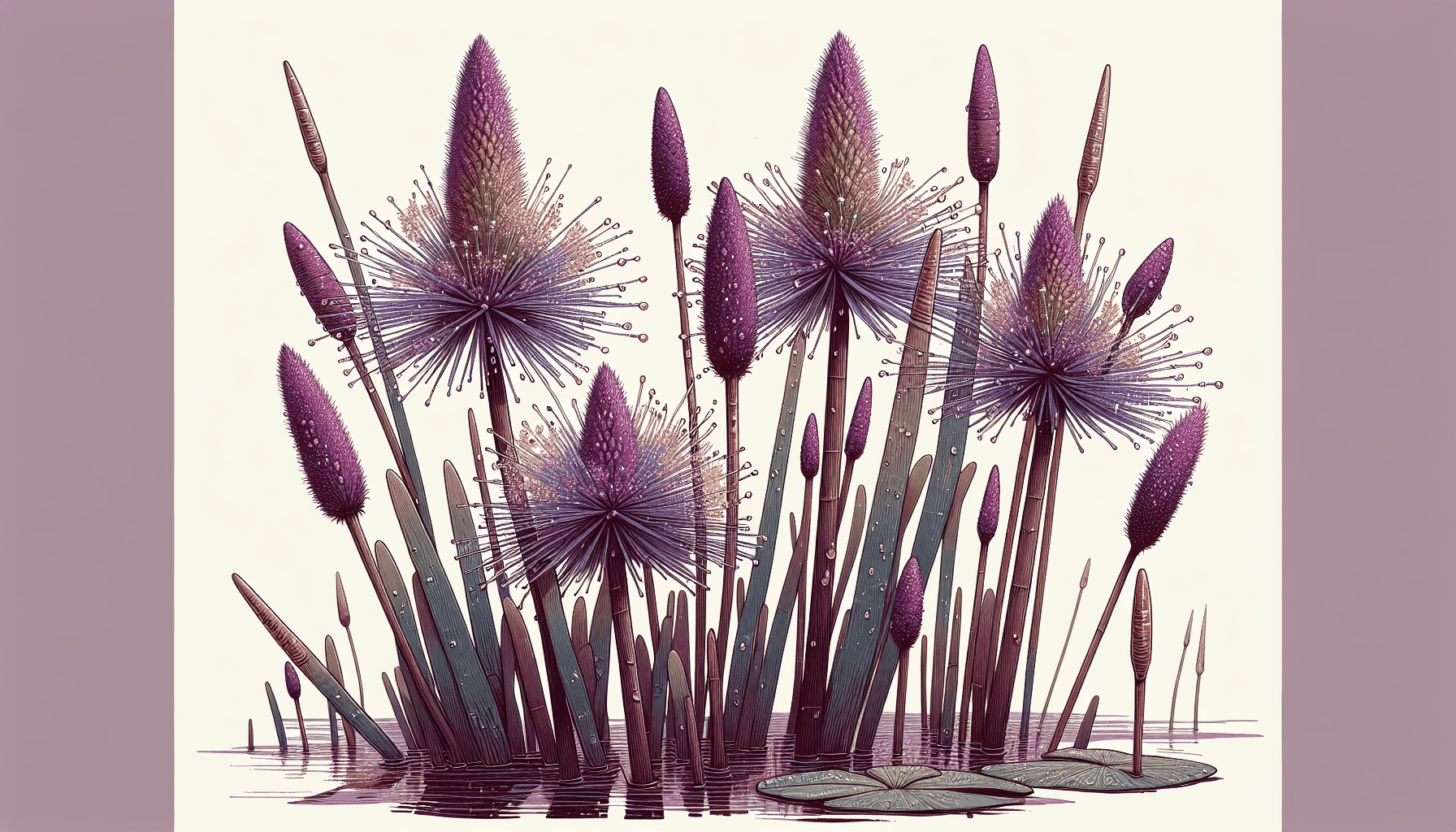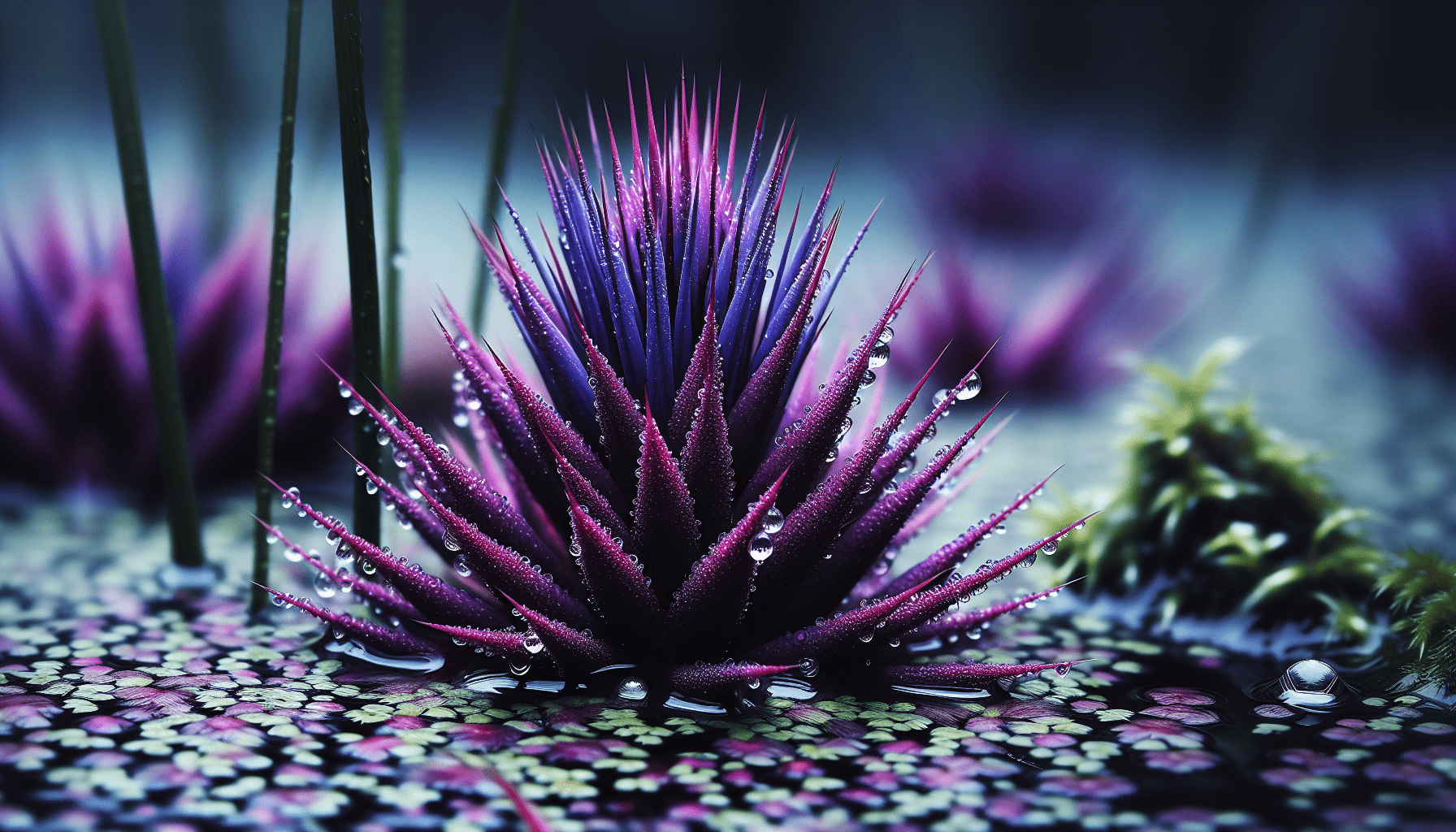As you embark on this exploration into the world of aquatic plants, you will become acquainted with an enriching account of the Purple Spike Rush. This sophisticated species adds a vibrant burst of color to the wetlands it inhabits. The ensuing discourse will shed light on its features, its distinct characteristics, why it is an often chosen natural aesthetic addition to various landscapes, and its valuable contribution to ecological balance. This article encapsulates a comprehensive understanding of this particular plant species, enriching your botanical knowledge and enhancing your appreciation of the diverse and complex realm of aquatic plant life.

Description and Characteristics of Purple Spike Rush
The Purple Spike Rush, scientifically known as Eleocharis atropurpurea, is a uniquely aquatic plant admired for its eye-catching color and distinct physical features.
Color and physical appearance
Evident from its name, the Purple Spike Rush exhibits a rich, dark purple hue in its stems. Its cylindrical, erect, and unbranched stems, which typically measure 10 to 100cm in height, create an aesthetically pleasing contrast against green aquatic landscapes. Adding to this contrast are its inconspicuous, minute scales wrapped around each stem’s apex, forming a spikelet that harbors its flowers.
Growth pattern and lifecycle
Purple Spike Rush grows in dense clumps or colonies, engaging in a perennial lifecycle. Each year, the plant enters a period of dormancy during winter, to resurface in the spring, reach its full bloom in summer, and then start to decay during autumn. Its annual cycle allows it to adapt and survive in different environmental conditions.
Special adaptations for aquatic life
Living in an aquatic environment requires distinctive modifications. Purple Spike Rush has evolved several such adaptations. One prominent feature is its pneumatophores or air tubes present in its roots and stems allowing gases to pass in and out, facilitating respiration even underwater. Moreover, its rhizome structure enables the plant to float on water surfaces.
Habitat and Distribution of Purple Spike Rush
Purple Spike Rush thrives in a wide variety of ecosystems, exhibiting a broad range of distribution.
Typical environments it thrives in
This aquatic plant principally thrives in freshwater environments. It prefers standing or slow-moving water bodies, such as lakes, swamps, marshes, river edges, and pond margins. It can also tolerate temporary flooding or consistently moist soil conditions.
Geographic range and spread
Purple Spike Rush is a cosmopolitan species with a global distribution. Found extensively across North and South America, Africa, Asia, and Europe, it has a unique ability to acclimate to disparate climatic zones, including tropical and temperate regions.
Factors influencing its distribution
Several factors influence the distribution of Purple Spike Rush. These may include water quality, salinity content, temperature fluctuations, light availability, substrate type, and competition with other aquatic flora. The extraordinary ability to endure a broad range of conditions contributes to its widespread dissemination.
Reproduction and Spread of Purple Spike Rush
Purple Spike Rush has an efficient reproduction system ensuring its continued spread and propagation.
Reproductive methods
Purple Spike Rush primarily reproduces sexually via seed production. Each spikelet on the plant’s apex constitutes flowers that mature to form seeds. It also reproduces vegetatively, with new stem growth emerging from its spreading underground stems or rhizomes.
Conditions required for germination
For seed germination, Purple Spike Rush requires the presence of superficial moisture. A steady supply of light, warm temperatures, and nutrient-rich substrate also significantly enhance the probability of successful germination.
Factors contributing to spread and propagation
The primary factor that contributes to the plant’s propagation is its prolific seed production and robust rhizomatic growth. Furthermore, water currents, wind action, and various animals assist in dispersing seeds across different locations, promoting colonization.
Ecological Significance of Purple Spike Rush
The Purple Spike Rush is not merely an attractive aquatic plant; it plays a vital role in maintaining ecological balance.
Role in the ecosystem
The plant aids in nutrient cycling, transforming the nutrients absorbed through its root system into digestible forms for numerous water organisms. Its dense clumps provide a suitable habitat and contribute to the breeding and nesting of various aquatic animals such as frogs, turtles, and several bird species.
Interactions with other organisms
In addition to interacting with a number of animal species, Purple Spike Rush has mutualistic relationships with some bacteria and fungi which aid in nitrogen fixation and mineral absorption, respectively. It may compete for resources with other vigorous aquatic plants but its ability to tolerate a wide range of conditions gives it a competitive advantage.
Impact on local biodiversity
By serving as a food supply, breeding ground, and protective shelter for various organisms, Purple Spike Rush significantly enhances local biodiversity. It also aids in stabilizing water bodies, helping other aquatic plants to establish and diversify the ecosystem.

Human Uses of Purple Spike Rush
Purple Spike Rush is both ecologically and economically valuable, having several beneficial applications for humans.
Utilization in landscaping and gardening
With its deep purple hue and distinctive form, Purple Spike Rush is an excellent choice for aquatic gardens and landscapes. It adds aesthetic value while simultaneously, its tolerance for different water levels makes it a practical option.
Medicinal and herbal usage
Traditionally, parts of the Purple Spike Rush have been utilized for their medicinal properties. Though there is limited scientific data to support these claims, some believe that the plant has antibacterial, diuretic, and anti-inflammatory properties.
Other traditional and cultural uses
In certain global communities, the plant’s stalks are used for weaving baskets, mats, and other handicrafts. Some tribes also incorporate the Purple Spike Rush in their cultural and religious ceremonies.
Threats and Conservation of Purple Spike Rush
Despite its global prevalence, the Purple Spike Rush faces multiple challenges that threaten its survival.
Common threats and their impact
Habitat degradation due to pollution, climate change, and urbanization, along with the invasion of exotic species, pose significant threats to this plant. These factors can adversely influence its growth, reproduction, and long-term survival, consequently threatening the biodiversity it supports.
Conservation status and initiatives
While the Purple Spike Rush is not currently listed as endangered or threatened, sustainable initiatives are needed to maintain its population. Initiatives may include habitat protection, pollution prevention and control, proper land use, and the promotion of native plant species cultivation.
Steps for individual conservation efforts
Individuals can contribute to the conservation of Purple Spike Rush by planting it in their local ponds or streams, maintaining natural habitats, and reducing the use of harmful aquatic pesticides. Educating the community about its ecological importance and encouraging native plant cultivation can also be beneficial.
Cultivation of Purple Spike Rush
Growing Purple Spike Rush is relatively straightforward, given its hardy nature and tolerance for varying conditions.
Ideal growth conditions and care
The plant prefers full sunlight to partial shade. It can tolerate either standing water or consistently moist soils, and it can grow in a wide range of soil textures, including sand, loam, or clay.
Common issues and their management
Caring for Purple Spike Rush is quite simple due to its resilience. Issues due to pests or diseases are rare. However, occasional trimming and removal of dead stems and leaves can keep the plant healthy and enhance its appearance.
Propagation techniques
Purple Spike Rush can be propagated by either seed or division of rhizomes. The seeds can be directly sowed into the moist substrate or pots, whereas the divided rhizomes can be carefully planted into the soil or dispersed in water bodies. Both methods will produce new plants reliably.
Purple Spike Rush in Aquaprone Ecosystems
Purple Spike Rush plays an important role in aquatic environments, particularly with regard to water quality and shoreline stabilization.
Importance in water filtration
Purple Spike Rush has a significant role in natural water filtration processes. Its dense growth and well-established root system efficiently prevent sediment erosion and filter out pollutants, maintaining water clarity and health.
As a indicator for water quality
The presence and healthy growth of Purple Spike Rush can often indicate good water quality. As it requires a certain quality of water for its growth, it serves as a natural biomonitor for assessing the aquatic environment’s health.
Role in shoreline stabilization
The plant’s robust rhizomes and dense growth often provide a natural boundary for water bodies. By stabilizing the shoreline, they prevent soil erosion, protect the coastline, and reduce the risk of flooding in surrounding areas.
Symbolism and Cultural Significance of Purple Spike Rush
Over the ages, the Purple Spike Rush has held various cultural significations and symbolisms.
Historical and cultural meaning
Historically, Purple Spike Rush was seen as a symbol of resilience and hardiness due to its ability to thrive in challenging conditions. In some cultures, the plant represents prosperity and abundance due to its high productivity and ecological contributions.
Use in art, literature and folklore
In art and literature, the Purple Spike Rush is often depicted as a symbol of beauty and tranquility, attributing to the serene aquatic landscapes it inhabits. Folklore in various communities often associates this plant with myths and legends about water deities and spirits.
Modern symbolism and significance
Today, Purple Spike Rush is often symbolic of environmental health, indicating good water quality and ecosystem balance. Furthermore, it can symbolize personal growth and adaptation through challenging circumstances, inspired by its own adaptability.
Research and Studies on Purple Spike Rush
Scientific study on Purple Spike Rush has been active, with numerous fascinating findings.
Notable research findings
Research has revealed the impressive adaptive capabilities of Purple Spike Rush, its exceptional reproductive efficiency, and its crucial ecological roles. Landmark findings have detailed the plant’s capacity to bioaccumulate heavy metals, highlighting its potential in phytoremediation processes.
Ongoing studies and their implications
Current studies are focusing on its potential medicinal properties, its use in wastewater treatment, and wider ecological implications. Such research, if successful, could contribute to our understanding of the plant’s capabilities and open new avenues for its application.
Future research potential
Much remains to be discovered about Purple Spike Rush. Its potential for environmental cleanup, medicinal applications, and wider ecological contributions offer promising areas for future research. By investing resources in understanding this fascinating aquatic plant better, we can harness its full potential while ensuring its conservation.